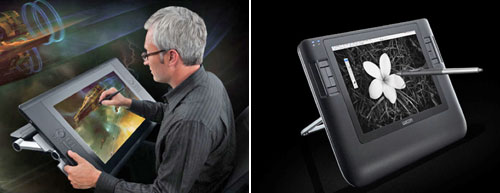What would get us to upgrade?
Some may remember our attempt at building a directly-on-screen pressure-sensitive tablets back in 2008. We had some success, but the display’s lack of brightness finally made us realize that if we really wanted such a tablet, we needed to cough up the $2000 for a Wacom Cintiq. A few years ago, Wacom came out with a smaller, lower cost, 12″ Cintiq
for around $1K. While more affordable, is not very portable as it still must be connected to a computer in order for it to operate.
Then we asked ourselves, what would we like to do on the iPad that is currently awkward but should be natural and expected? The one feature we kept coming back to was “pressure-sensitivity,” something we have had with our Wacom graphics tablets for close to a decade and have been hoping to see available on the iPad. We believe that pressure-sensitivity is the one missing interface element which would complete the iPad tablet experience.

It is true that there are apps today which simulate the effect of pressure. On the whole, the effect is rather forced and the results wanting. Lifting the finger sometimes create a trailing point, the speed of the movement does not always affect the bristles the same way, etc. In all of the apps, the user must learn the behavior of the “brush” and none of the effects are intuitive or feel natural. The entire process leaves the user wanting.
So, what would get us to upgrade to the next iPad? An iPad with a pressure-sensitive touchscreen. Once Apple solves the pressure-sensitivity problem, they could easily justify larger tablets (12″, 15″, 21″) and higher price points for targeted markets (art, photography, etc.) and applications.
If Apple released an iPad 4 with a pressure-sensitive touchscreen, we could see ourselves paying a couple-hundred-dollars premium for that capability. If Apple added the feature to their 24″ iMac, we may even be tempted to actually buy a brand new computer, something which we have not done in quite a long time.









Leave a comment